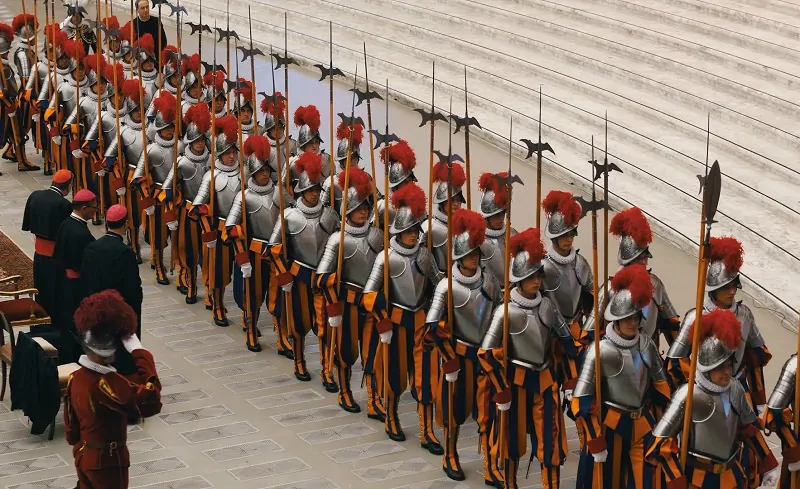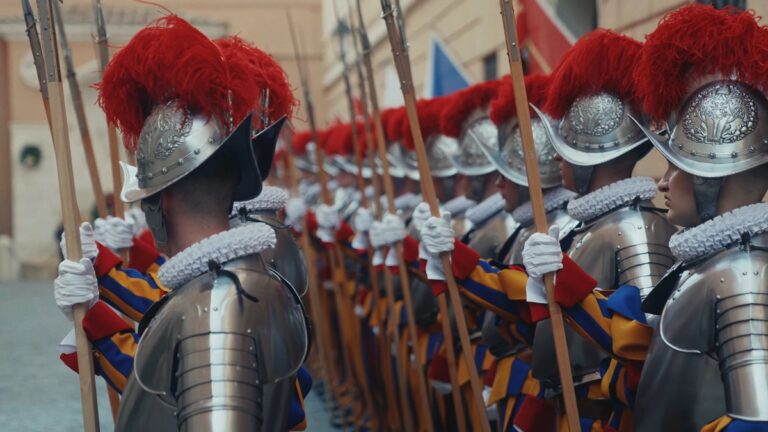Centuries have passed since Pope Julius II summoned soldiers from the Swiss cantons to guard the Vatican, yet the Pontifical Swiss Guard remains a fully armed military unit rooted in both tradition and readiness. Their weapons reflect a history of bloodshed, honor, and transition.
These arms were never symbolic. Every piece, from the gleaming halberd to modern assault rifles, carried a purpose that served a single mission—protecting the life of the Pope at all costs.
Tradition Did Not Begin with Velvet Uniforms

Paintings of 16th-century mercenaries marching into Rome often highlight the color. Most fixate on the design of the uniform. That visual appeal has distracted generations from the harder truth. The earliest Swiss Guards carried steel forged for war. Their uniforms were not what made them dangerous. It was their discipline and their weapons that kept them alive and made them irreplaceable in a city filled with shifting alliances.
The first guards arrived with halberds, short swords, and roundel daggers. Their combat training began in the mountains, not on parade grounds. They had fought and won against armored cavalry in open terrain. They stood firm against pike charges. Their reputation stretched across Europe long before the Vatican signed a contract.
Swiss commanders taught techniques meant to work in tightly packed formations. The halberd was never used alone. It worked with body positioning, shoulder-line formations, and coordinated footwork. The reach gave them control over opponents. The blade could slash or hook shields. The spear point could penetrate chainmail. No single feature defined it. The weapon relied on its combination of functions to overwhelm an enemy.
Modern viewers often mistake halberds for decorative props. That belief collapses under any serious study of their original use. In fact, the training today still includes real halberd drills for a reason. Vatican security values historical knowledge, not just visual display.
The 1527 Sack of Rome Proved the Weapons Were Not for Show

By the time Emperor Charles V’s mutinous troops reached Rome in 1527, Swiss Guards had already faced political pressure and internal Vatican power struggles. Nothing prepared them for what happened on May 6. Over 20,000 imperial soldiers, many unpaid and hungry, stormed the city in a brutal campaign of looting and execution. The Swiss Guard stood at the gates of St. Peter’s Basilica. Only 189 men faced an army.
The halberd became the last line of defense. Guards formed protective arcs in tight formation as Pope Clement VII fled through the Passetto di Borgo, a hidden corridor connecting the Vatican to Castel Sant’Angelo. Records confirm that 147 Swiss Guards died that day, most using polearms in direct hand-to-hand combat. They held their ground until the Pope was safely out of reach. Survivors did not retreat. They stood until they were cut down.
No modern training scenario can simulate that day, but every new Swiss Guard learns its story. Each halberd used in ceremonial rotation today draws from that battle’s memory. It is more than a design. It is a survivor’s weapon.
Firearms Enter the Vatican Arsenal
By the 17th century, gunpowder had already reshaped European warfare. Pikes and halberds declined as muskets took the field. Vatican leadership adapted slowly but did not resist the shift. By the 1800s, Swiss Guards used flintlocks and later breech-loading rifles during internal revolts and external political threats.
Not every Pope welcomed modern weapons. Some periods emphasized ceremonial functions over practical defense. But the Vatican’s need for real protection surged again in the 20th century. Assassination attempts, global conflicts, and political instability forced Vatican security to overhaul its arsenal.
Today, the Swiss Guard uses a combination of traditional weapons and modern firearms. Their current inventory is not published in full, but confirmed equipment includes the following:
| Weapon Name | Type | Primary Use | Origin |
|---|---|---|---|
| SIG Sauer P220 | Semi-automatic pistol | Personal sidearm | Switzerland |
| SIG SG 550 | Assault rifle | Tactical defense, emergencies | Switzerland |
| Glock 19 | Semi-automatic pistol | Close protection | Austria |
| FN P90 | Personal defense weapon | VIP protection | Belgium |
| Steyr TMP | Machine pistol | Special operations | Austria |
Training Combines Old Tactics with Modern Strategy
Swiss Guards do not rely on weapons alone. Each recruit undergoes intensive preparation at military academies in Switzerland before arriving in Rome. Once sworn in, the training continues. Firearms proficiency is mandatory. Hand-to-hand combat drills are included. Simulated attacks, coordinated security protocols, and crowd-control strategies are part of the daily routine.
Ceremonial duties—guarding entrances, standing post during events—do not exclude tactical readiness. On high-security days, guards rotate with Vatican Gendarmerie and Italian military support units. Each Swiss Guard knows that rifles must be handled with the same discipline as halberds.
Beyond tactics, their training focuses on reaction speed. In open-air events such as Easter Mass or papal audiences, threats can emerge at close range without warning. Every weapon carried must be accessible and fully operational under pressure.
Halberds and Firearms Exist Together

The visual contrast between a Renaissance halberd and a modern SIG SG 550 reflects more than time. It proves that the Vatican sees no conflict in mixing old forms with new function. Halberds continue to hold symbolic power, but every Swiss Guard trained with one knows its weight, balance, and attack range.
During papal ceremonies, guards carry polearms and wear full dress uniform. During private audiences, indoor duty, and high-risk days, firearms are prioritized. The switch happens quietly. Tourists may not notice. Security teams do.
Each shift combines historical honor with calculated defense. No weapon in the Swiss Guard’s arsenal is random. Everything, down to blade length and caliber, serves purpose.
Security Today Is Not a Performance
Modern threats require modern responses. The attempted assassination of Pope John Paul II in 1981 changed the Vatican’s internal security structure. The shooter fired at close range in a public square. Swiss Guards were present but not directly involved in the arrest. That incident accelerated changes behind the scenes.
Weapon protocols became stricter. Surveillance systems expanded. Inter-agency coordination improved. The Swiss Guard updated its armory again. Submachine guns replaced older sidearms. Communication devices were added. Psychological screening for recruits became more detailed.
Despite the clear increase in modern gear, the halberd never disappeared. Its presence reminds the world that loyalty and readiness can coexist across centuries. A weapon once used in the mud of medieval Europe now stands beneath the marble of Vatican halls. Its edge may not drip with blood, but it still commands attention.
Craftsmanship and Symbolism in Every Piece
Weapons used by the Swiss Guard are not bought in bulk or handed out like standard military gear. Every halberd, sword, and firearm is inspected and maintained with precision. The halberds are forged by artisans in Switzerland, often made using traditional techniques.
Each weapon includes marks of identity. Some halberds carry engravings of the Vatican coat of arms. Others bear the initials of guards who died in service. This level of personalization creates a connection between tool and task. A rifle is not just a weapon. It is part of a tradition of guardianship. A sword is not just for looks. It echoes centuries of sacrifice.
Swords are issued for formal events. Blades are polished before each deployment. Even unused weapons are cleaned and maintained weekly.
Last Words
No military unit in the world carries a halberd without irony—except the Pontifical Swiss Guard. Every weapon in their hands holds two duties. One speaks to history. The other demands modern readiness.
A halberd may look ceremonial to casual tourists, but to a trained guard, it is still a weapon with defined range, weight, and purpose. That blade once cracked the ribs of cavalrymen. It now flanks the gates of the Apostolic Palace. No steel stays useful for five centuries without earning its place.

